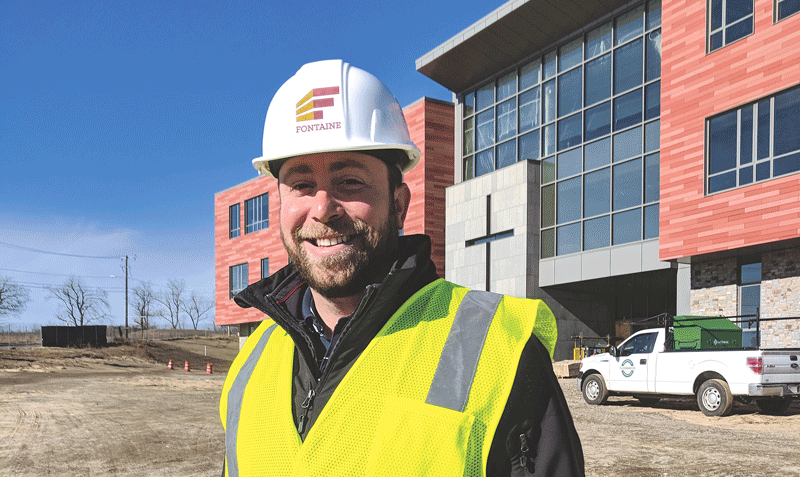
Construction Industry Struggles to Attract Young Talent
Building Concern

David Fontaine Jr. outside one of his company’s current high-profile projects, the new Pope Francis High School.
The good news for area contractors is that construction is humming along in Western Mass. The bad news? A limited talent pool has been stretched even thinner, and companies often struggle to find skilled workers. It’s actually a national problem, as a decades-long emphasis on college degrees has steered young people away from the trades as a viable career option. That needs to change, industry experts say, if they want to keep growing.
Long before the MGM Springfield casino project put hundreds of workers — carpenters, ironworkers, plumbers, electricians, you name it — to work, the region’s construction companies found themselves struggling with a critical element of the business: finding workers.
n some ways, it’s a good problem to have — it means construction activity is up regionally — but it may not be sustainable.
“In Western Mass., it’s a combination of things,” said David Fontaine Jr., president of Fontaine Brothers in Springfield. “Everyone is very busy, with a lot of large projects going on and demanding a lot of labor. And then, you’re seeing a shortage of people entering the trades. Its hard to distinguish which is more the culprit right now, but it’s definitely those two things going on.”
Fran Beaulieu, president of Phil Beaulieu & Sons Home Improvement in Chicopee, agrees.
“There is a shortage, and it’s hard to find new help; they just don’t come knocking on your door,” he told BusinessWest. “So we have to create from within. We do have a nice crop of younger guys working for us, under 30, and we’re doing everything we can to retain them — making a better work environment, making it profitable for them, and showing them there is a future in this. That’s how you retain them.”
Attracting new blood to the field? That’s a little more challenging.
“It’s hard work,” he said, perhaps referring to both the actual jobs and convincing people to do them. “When you decide you want to be a carpenter, plumber, or electrician, you know it will be hard work. And there will be days when it’s 28 degrees out — those are the bad days. But then there are a lot of good days — nice, sunny days when it’s 75 degrees out, and people sitting at their desks wish they were outside.”
It doesn’t help, he noted, that some elements of society have looked down at the construction trades over the past quarter-century, pushing hard the idea that young people need to earn a college degree.
Yet, “if you take the job professionally, you can do really, really well,” he said, noting that someone who starts at age 18 may be earning $80,000 to $90,000 by the time they’re 23 or 24, while someone who went to college is just starting out in an entry-level job, often saddled with six-figure debt.
“And that’s working for someone else; never mind venturing out and doing your own projects,” he went on. “I always tell young guys, ‘the carpenter becomes the builder, the builder becomes the developer, and the developer becomes the real-estate owner.’ After five or six years, they’re often no longer wearing a toolbelt, because they’re managing the people working for them. This business can be very lucrative; there’s a lot of opportunity. We all need a plumber from time to time.”
If You Build It…
America needs a lot more than that. Last year, the National Assoc. of Home Builders’ Economics and Housing Policy Group conducted a national online survey of 2,001 young adults (ages 18-25) in response to growing concerns over labor supply in the trades. The current scarcity is all the more concerning, the report noted, given projections from the Bureau of Labor Statistics that the construction sector will add around 790,000 new jobs between 2014 and 2024.
Among respondents who say they want to work in construction, 80% cited good pay as a reason why — the top motivator, in fact. Other reasons include the ability to obtain useful skills (74%), the ability to work outside (53%), the ability to start one’s own business (50%), and the fact that it doesn’t require a college degree (37%).
On the other hand, when respondents who said they were not interested in a construction career were asked why, the top reason was the desire for a less physically demanding job, cited by 48%, followed by the difficulty of the work (32%), the desire for an office job (26%), the desire to open their own business (20%) and, interestingly, the desire to make more money than people in the trades make (19%).
Interesting, because there seems to be a perception gap when it comes to salary. Of the respondents uninterested in a construction career, almost half (44%) think annual salary averages less than $51,000, and only 2% think someone can earn more than $100,000.
Still, the report notes, “most young adults who have yet to make up their minds on a career see very little chance they would join the trades even if the pay was high. This decision is based more on their view that construction work is physically demanding and difficult, and less so on often-repeated presumptions that it is because they prefer ‘new economy’ type jobs, or because the work is seasonal or requires being outside in the elements.

Fran Beaulieu says recruiting talent is a constant challenge in the industry, which is why he focuses on creating a strong culture of retention and advancement.
“The helpful news for the construction industry is that many 18- to 25-year olds who in theory would not like to work in the trades would reconsider it for an annual salary of $75,000 or more,” it continues. “Although the average annual salary is below this for the trades relevant to the home building industry, $75,000-plus salaries are available for the top 10% to 25% of workers, and it may be worthwhile to make this more widely known.”
Fontaine is doing his part.
“I think this is a great career,” he said. “We have a lot of people here who have had long, successful careers. And certainly, a lot of other contractors in the area have employed a lot of the same people for years and years. A lot of that is the unions, which have great healthcare programs and pension programs that people can take advantage of.”
It’s the other side of the coin, the too-slow trickle of younger workers, that has contractors concerned. Take, for example, these comments published in BusinessWest during 2017 alone:
• From Joe Marois, president of Marois Construction in South Hadley: “Now we’re being faced with a labor shortage, which is always a challenge. That’s the nature of construction — it’s never perfect. I don’t know to what extent the casino is affecting that, but basically, the labor pool for tradespeople is very small.”
• From Laurie Raymaakers, co-owner of J.L. Raymaakers & Sons in Westfield: “What we’re not seeing is qualified or experienced people to hire to grow with us. The need for skilled tradespeople is not going away, and it’s not just us — everyone we talk to within the industry says the same thing. And it’s a field where you can make a very good wage.”
• And from Brian Ruud, owner of Vista Home Improvement in Chicopee, who noted that companies have to be willing to pay competitive wages for good talent: “It’s hard to find good people … We’re happy with where we are now. We could grow more if we had the right people, but we’ll find them.”

Jason Garand says the local carpenters union has developed programs to introduce young people to well-paying careers in the trade.
Jason Garand, business manager of Carpenters Local Union 336 in Springfield, agreed that the promise of good pay is a must to attract young people, noting that, if an 18-year-old with no plans to go to college can earn $11 an hour at McDonald’s or $13 an hour on a job site, doing hard work in the elements, he might choose fast food, even though there’s a much lower career ceiling in that field — perhaps store management, but no higher.
“He might say, ‘I’ll take the easier path in the short term,’ but in the long term, it’s a dead end,” he noted.
As one of its efforts to raise the profile of its trade, the union recently partnered with Putnam Vocational Technical Academy to bring two students in as apprentices to work on the MGM Springfield project.
“We’re giving them a taste of what construction is all about, and our rate is $16 to start — that’s an apprentice, walking in with no skills,” Garand said, adding that, in the long term, “the union has a wage and benefit package that puts you in the middle class.”
Daily Grind
Fontaine was quick to note that the office side of the business isn’t seeing the same shortage, as the flow of young people graduating from schools like Wentworth Institute of Technology or Worcester Polytechnic Institute with degrees in construction management or engineering has been steady.
“We’re seeing more of a shortage of people going into the trades, the laborers — carpenters, plumbers, pipefitters.”
He added that young people who come from families with construction trades in their background are much more likely to enter the field themselves. Meanwhile, Beaulieu said, immigrants, many from South and Central America or Eastern Europe, are entering the field locally at a higher rate than American-born young people.
“There are some drawbacks,” Fontaine said. “There’s a lot of travel involved, a lot of driving to and from job sites. You’re up and on the road early; some people are averse to that. And there are fluctuations in the construction industry; the market is going to go up and down. It’s not a career where you expect to be employed 52 weeks a year. Especially in the early stage of a career, that can drive some people away, too.”
Beaulieu agreed that it’s not the easiest career. “It’s tough on the body; you have to take care of yourself and stay thin — but the job itself will keep you thin.”
For whatever reason, he went on, “I don’t think a lot of seniors and juniors, when they’re thinking about career opportunities, are necessarily thinking about a trade. But, on the other hand, you don’t have to leave college with huge debt, you’re going to get paid right out of the gate, and five or six years later, you can be a master at the trade.”
With that in mind, Beaulieu says he focuses on training from within, so that his own people can grow in their careers, stay with the firm, and advance to project management and beyond.
The Foundation of the Wall and Ceiling Industry recently conducted its own study on why the construction business struggles to attract new talent, and emerged with five takeaways:
• Young people thrive on regular communication. They enjoy collaborating on teams. Mentoring programs will encourage them to stay on board with a company.
• What matters to a young person about work differs from older generations. Young people enjoy technology, and the construction industry is using more of it. Experts recommend appealing to young people’s interest in technology.
• Company culture is important. Young people want jobs that come with perks and ‘come and go as you like’ atmospheres, which are common among high-tech firms. To be appealing, construction firms need to create ‘good fit’ cultures.
• Companies need to develop new recruitment strategies to meet the long-term employment forecasts, which are positive.
• The construction industry needs to target the right group of young people for field positions — those out of high school but not in college. An older group, attending two-year community-college programs, is an up-and-coming recruitment target as well; they may have tried a career path or two and are ready to settle down.
Like others BusinessWest has spoken with recently about this challenge, Fontaine said there’s no one fix, but added that the tide may be turning when it comes to getting the word out that careers in the construction trades are more stable and lucrative than young people might think.
“I think it’s been a challenge for a while, but the unions have done a good job recruiting people into the trades the last couple of years; they’ve done a good job, especially with some projects like the casino, of reaching into the local market,” he noted. “People are becoming more aware of the opportunities than they were five years ago. But it’s still a constant challenge to get and keep good people.”
Joseph Bednar can be reached at [email protected]




